
November 13: Updated with final wave of PSAT scores.
College Board released scores in three waves depending on when students took the PSAT. We have now received scores summaries for all three waves. It is possible that some late scores will still dribble in, but we are not expecting any changes. The results point to a strong upward trend in cutoffs for the class of 2026. You are welcome to jump to the table of estimates below, but we encourage students and families to read more about how we came to those estimates. For more information on the National Merit Program, in general, you may want to read Compass’s National Merit Scholarship Program Explained. If you want to browse almost two decades’ worth of cutoffs, you can find them in Compass’s National Merit Historical Cutoffs.
What is a Semifinalist Cutoff?
Each year almost 17,000 juniors are named Semifinalists in the National Merit Scholarship Program and continue on in the hopes of being one of the 15,000 Finalists and, eventually, one of the 7,500 scholarship recipients. The score needed to qualify as a Semifinalist varies by state and is known as the “cutoff.” Every student scoring at or above the Semifinalist cutoff qualifies. The cutoff is not based on a student’s overall PSAT score but on the Selection Index. The Selection Index is listed on a student’s PSAT score report. It can be calculated by doubling the ERW score, adding the Math score, and then dividing the sum by 10. For example, a 720 ERW / 730 M would have a Selection Index of (720 x 2 + 730)/10 = 217. For the class of 2025, cutoffs ranged from 208 to 223.
What is a Commended Student Cutoff?
If you performed well on the PSAT but do not qualify as a Semifinalist, you have the opportunity to be named as a Commended Student. Unlike the Semifinalist cutoffs, the Commended cutoff is set nationally. For last year’s class it was 208. Approximately 36,000 students are named Commended Students each year.
Why does Compass believe that we are likely to see cutoffs, as a whole, go up?
College Board releases very little data about score distribution. The number of top scorers is the most critical piece of information that we get this early in the process. While we do not know the number of students scoring at a particular Selection Index, we do know the number of students scoring in the 1400-1520 range, which roughly correlates to Selection Indexes of 210-228. The class of 2026 ranks 4th in the ten years since the PSAT scoring was overhauled, and this year sees the highest ever percentage of top scores. The number of Semifinalists and Commended students are capped, so cutoffs are likely to rise. But not all cutoffs. The numbers we have seen are at the national level and there is always churn at the state level. What we believe, however, is that more cutoffs will go up than down.
There is a good correlation between the 1400-1520 band of students and the Commended Student score. We believe that the Commended cutoff will come in between 209 and 211, with a 210 being most likely. Based on our historical archive of Semifinalist and Commended cutoffs, we believe that the average Semifinalist cutoff will go up this year.
Will I find out my status right away?
No. In fact, students don’t learn of Semifinalist status until September of senior year. Compass tracks data on current year performance and historical records to provides estimates and updates between PSAT score release and the Semifinalist announcements. Last year — the first year of the digital PSAT — saw a noticeable uptick in scores. Only one state — South Dakota — saw a lower cutoff versus the previous year’s. Was this a onetime quirk? Based on early results for the class of 2026, we do not believe that it was. The upward trend — whether due to the new test format, recovery from COVID-era learning loss, or other factors — appears to be continuing.
One mistake students make is thinking that the cutoff for one year will be the same in the next year. Cutoffs change every year, sometimes by as much as 5 or 6 points (granted, that’s unusual). Compass emphasizes an Estimated Range, which is likely to include the ultimate cutoff. Within that range, we do provide our Most Likely. That score represents our best estimate based on the known factors, but there are many unknown factors. Most of our PSAT performance data are for national results. So we can usually peg the Commended cutoff within a point or two. States, however, can move in different directions. More Alaskan students may test this year. Some strong Rhode Island prep schools may have decided to stop offering the PSAT. A COVID outbreak in Montana could mean more students using Alternate Entry and entering the competition using SAT scores. Below is a table that shows how many states in each of the last 17 years saw increases, decreases, or no change. There has never been a year where even half of all state cutoffs remain unchanged.
The chart below divides the 50 states into those that saw increases (blue), those that remained unchanged (gray), and those that saw declines (red).
Historically, a change in cutoff is more likely than not. Over the decade from 2015 – 2024, Semifinalist cutoffs remained unchanged only about one-third of the time.
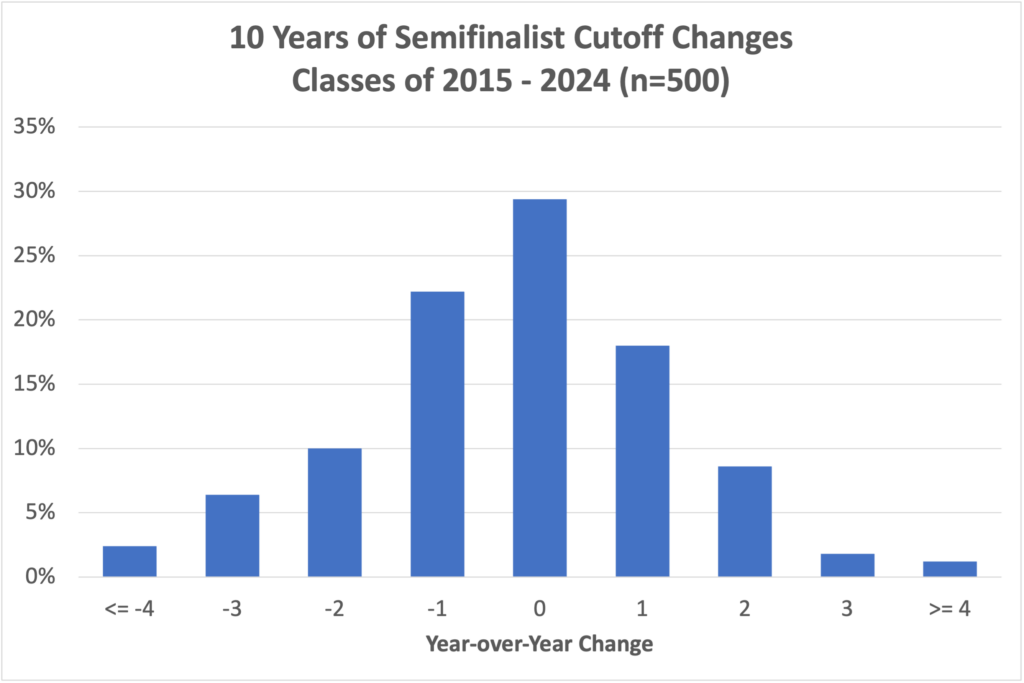
We believe that a table of results from this class will skew to the right.
Small states have more volatile cutoffs than large states, but there can be surprises across the board. The PSAT had a significant overhaul in scoring in 2017. If we look at the minimum and maximum cutoffs during the 9-year period from then until the class of 2025, we see that the 13 largest states (about 100,000 or more high school graduates) average a 2.8-point differential. New Jersey has a 1-point differential, since its lowest cutoff is 222 and highest is 223. The smallest states (fewer than 30,000 graduates) have a 6.2 point differential. Alaska has been as low as 208 and as high as 217! The medium-sized states average a 5-point difference between minimum and maximum.
Here are Compass’s current estimates for Semifinalist cutoffs for the class of 2026:
State | Class of 2026 Estimated Range | Class of 2026 Most Likely | Class of 2025 (Actual) | Class of 2024 (Actual) | Class of 2023 (Actual) | # of 2025 Semifinalists |
|---|---|---|---|---|---|---|
| Alabama | 210 - 216 | 214 | 212 | 210 | 212 | 267 |
| Alaska | 210 - 216 | 214 | 214 | 209 | 210 | 36 |
| Arizona | 215 - 220 | 218 | 217 | 216 | 214 | 401 |
| Arkansas | 210 - 215 | 213 | 213 | 210 | 210 | 134 |
| California | 220 - 223 | 222 | 221 | 221 | 220 | 2103 |
| Colorado | 216 - 221 | 218 | 218 | 216 | 217 | 272 |
| Connecticut | 220 - 222 | 221 | 221 | 221 | 221 | 177 |
| Delaware | 218 - 221 | 220 | 219 | 219 | 218 | 43 |
| District of Columbia | 222 - 224 | 223 | 223 | 223 | 223 | 47 |
| Florida | 216 - 220 | 218 | 217 | 216 | 216 | 972 |
| Georgia | 217 - 221 | 219 | 218 | 217 | 218 | 624 |
| Hawaii | 215 - 220 | 218 | 217 | 217 | 215 | 74 |
| Idaho | 212 - 217 | 214 | 213 | 211 | 215 | 102 |
| Illinois | 218 - 222 | 220 | 220 | 219 | 219 | 738 |
| Indiana | 214 - 219 | 217 | 217 | 216 | 214 | 304 |
| Iowa | 211 - 217 | 214 | 212 | 210 | 212 | 156 |
| Kansas | 213 - 219 | 216 | 215 | 214 | 214 | 142 |
| Kentucky | 211 - 217 | 214 | 213 | 211 | 212 | 202 |
| Louisiana | 212 - 217 | 215 | 214 | 214 | 213 | 238 |
| Maine | 212 - 217 | 215 | 214 | 213 | 215 | 53 |
| Maryland | 221 - 224 | 222 | 222 | 221 | 222 | 296 |
| Massachusetts | 221 - 224 | 223 | 223 | 222 | 220 | 294 |
| Michigan | 216 - 220 | 218 | 218 | 217 | 218 | 511 |
| Minnesota | 216 - 220 | 218 | 217 | 216 | 216 | 288 |
| Mississippi | 210 - 215 | 213 | 212 | 209 | 210 | 155 |
| Missouri | 214 - 218 | 216 | 215 | 214 | 213 | 276 |
| Montana | 208 - 213 | 210 | 209 | 209 | 207 | 45 |
| Nebraska | 210 - 216 | 213 | 211 | 210 | 212 | 118 |
| Nevada | 211 - 218 | 215 | 214 | 211 | 210 | 162 |
| New Hampshire | 214 - 219 | 217 | 217 | 215 | 213 | 55 |
| New Jersey | 222 - 224 | 223 | 223 | 223 | 223 | 474 |
| New Mexico | 209 - 215 | 212 | 211 | 207 | 208 | 94 |
| New York | 219 - 221 | 220 | 220 | 220 | 219 | 1089 |
| North Carolina | 216 - 220 | 218 | 218 | 217 | 217 | 518 |
| North Dakota | 209 - 213 | 210 | 210 | 207 | 209 | 28 |
| Ohio | 215 - 219 | 217 | 217 | 216 | 216 | 582 |
| Oklahoma | 209 - 215 | 212 | 211 | 208 | 211 | 214 |
| Oregon | 215 - 220 | 217 | 216 | 216 | 216 | 205 |
| Pennsylvania | 217 - 221 | 219 | 219 | 219 | 218 | 583 |
| Rhode Island | 213 - 220 | 217 | 217 | 215 | 216 | 50 |
| South Carolina | 210 - 217 | 215 | 214 | 209 | 213 | 234 |
| South Dakota | 209 - 214 | 211 | 208 | 209 | 212 | 41 |
| Tennessee | 215 - 219 | 218 | 217 | 217 | 215 | 319 |
| Texas | 218 - 221 | 220 | 219 | 219 | 219 | 1714 |
| Utah | 210 - 216 | 213 | 211 | 209 | 211 | 195 |
| Vermont | 211 - 217 | 215 | 215 | 212 | 213 | 33 |
| Virginia | 220 - 223 | 222 | 222 | 219 | 221 | 394 |
| Washington | 220 - 223 | 221 | 222 | 220 | 220 | 358 |
| West Virginia | 209 - 212 | 210 | 209 | 207 | 207 | 66 |
| Wisconsin | 213 - 217 | 215 | 214 | 213 | 213 | 289 |
| Wyoming | 209 - 213 | 211 | 209 | 207 | 207 | 24 |
| U.S. Territories | 209 - 211 | 210 | 208 | 207 | 207 | 45 |
| Studying Abroad | 222 - 224 | 223 | 223 | 223 | 223 | 112 |
| Commended | 209 - 211 | 210 | 208 | 207 | 207 |
If you’d like to see even more historical data, you can find cutoffs going back to 2008 in Compass’s National Merit Historical Cutoffs.
Why does each state have its own Semifinalist cutoff if the program is NATIONAL Merit?
This is always a hot button question. NMSC allocates the approximately 17,000 Semifinalists among states based on the annual number of high school graduates. That way, students across the nation are represented. It also means that there are very different qualifying standards from state to state. A Massachusetts student with a 220 might miss out on being a Semifinalist. If she lived 10 miles away in New Hampshire, she would qualify.
NMSC sets a target number of Semifinalists for a state. For example, California sees about 2,000 Semifinalists every year, Michigan 500, and Wyoming 25. In each state, NMSC determines the Selection Index that comes closest to matching its target number of Semifinalists. If 1,900 California students score 222 and higher and 2,050 score 221 or higher, then the Semifinalist cutoff would be 221 (this assumes that the target is exactly 2,000). Because score levels can get crowded, it is easy for cutoffs to move up or down a point even when there is minimal change in testing behavior or performance.
No Semifinalist cutoff can be lower than the national Commended level. Cutoffs for the District of Columbia and for U.S. students studying abroad are set at the highest state cutoff (typically New Jersey). The cutoff for students in U.S. territories and possessions falls at the Commended level each year. Boarding schools are grouped by region. The cutoff for a given region is the highest state cutoff within the region.
Why does the number of top scorers vary from year to year?
While there are changes in the number of students taking the PSAT/NMSQT, there can also be small flaws in test scaling that play a role. Prior to the digital PSAT, a single test form was seen by a large percentage of test takers. Something amiss with that single form could impact selection cutoffs across the country. The digital PSAT is constructed differently. Students receive unique form codes drawn from a large pool of problems. Scaled scores are generated based on the characteristics of those problems. In theory, this should make scores more stable. College Board’s early studies have found an extremely high correlation between the paper-and-pencil test and digital test. Still, even with its adaptive nature, the uncertainty remains as to whether the much shorter test can reliably score students at the 700-760 end of the scale.
What if I missed the PSAT because of illness or other legitimate reason?
You may still be able to enter the scholarship program by applying for Alternate Entry using an SAT score. Find information about last year’s process in Compass’s explanation of National Merit alternate entry.
When are National Merit Semifinalists announced?
The Commended cutoff becomes unofficially known by the end of April. The lists of Semifinalists are not distributed to high schools until the end of August. NMSC sets a press embargo on Semifinalist announcement until mid-September, but schools are allowed to notify students before that date. NMSC does not send Commended Student letters to high schools until mid-September. Compass will keep students updated on developments as those dates approach.
Do state and national percentiles indicate whether I will be a National Merit Semifinalist?
No! Approximately 1% of test takers qualify as Semifinalists each year, so it is tempting to view a 99th percentile score as indicating a high enough score — especially now that College Board provides students with percentiles by state. There are any number of flaws that rule out using percentiles as a quick way of determining National Merit status.
- Percentiles are based on section scores or total score, not Selection Index
- Percentiles are rounded. There is a large difference, from a National Merit perspective, between the top 0.51% and the top 1.49%
- Percentiles reveal the percentage of students at or below a certain score, but the “at” part is important when NMSC is determining cutoffs.
- The number of Semifinalists is based on the number of high school graduates in a state, not the number of PSAT takers. Percentiles are based on PSAT takers. States have widely varying participation rates.
- Most definitive of all: Percentiles do not reflect the current year’s scores! They are based on the prior 3 years’ performance. They are set even before the test is given. And if you are going to use prior history, why not use the completely accurate record of prior National Merit cutoffs rather than the highly suspect percentiles?
Entry requirements for National Merit versus qualifying for National Merit.
Your PSAT/NMSQT score report tells you whether you meet the eligibility requirements for the NMSP. In general, juniors taking the October PSAT are eligible. If you have an asterisk next to your Selection Index, it means that your answers to the entrance questions have made you ineligible. Your answers are conveniently noted on your score report. If you think there is an error, you will also find instructions on how to contact NMSC. Meeting the eligibility requirements simply means that your score will be considered. Approximately 1.4 million students enter the competition each year. Only about 53,000 students will be named as Commended Students, Semifinalists, Finalists, or Scholars. See National Merit Explained for more information.

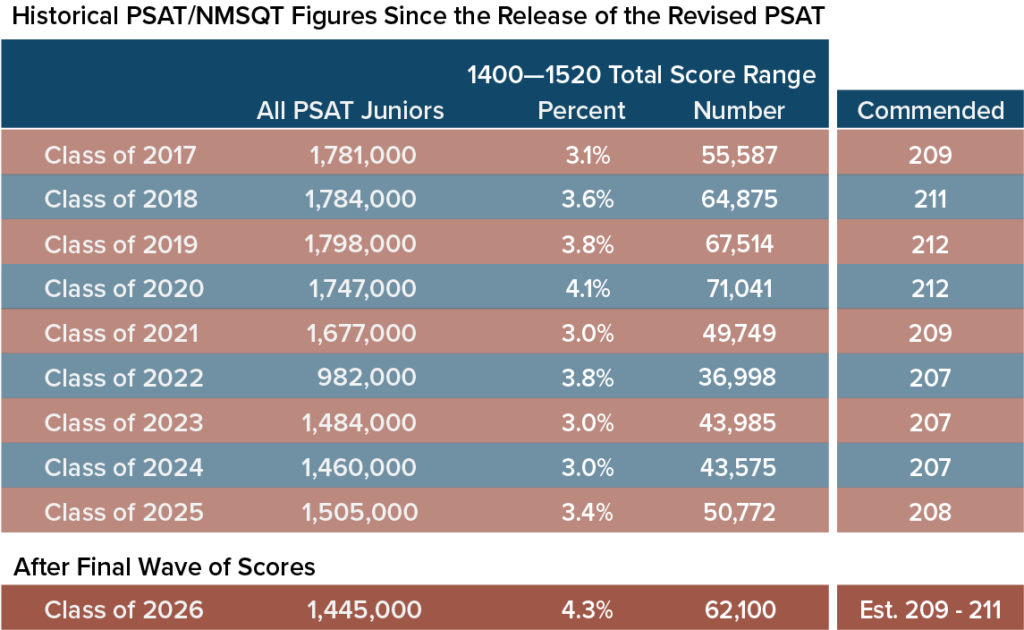
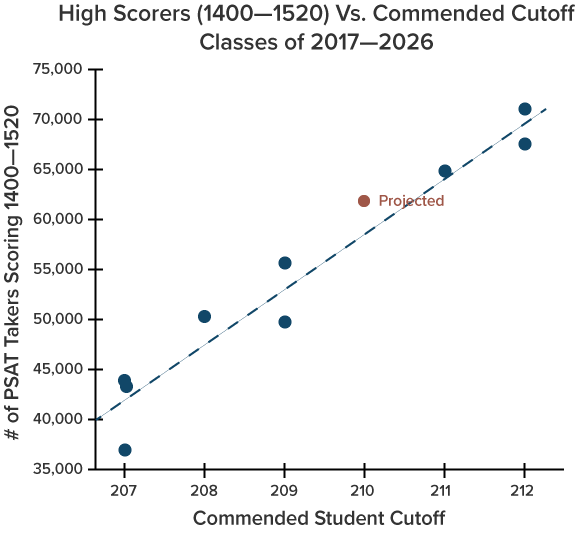
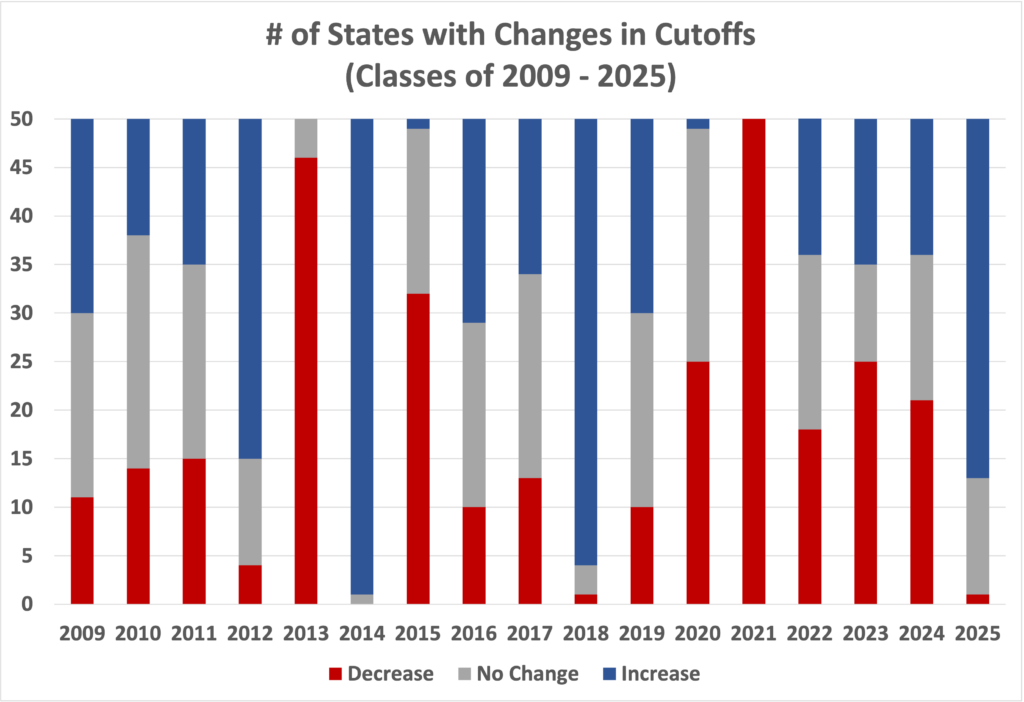
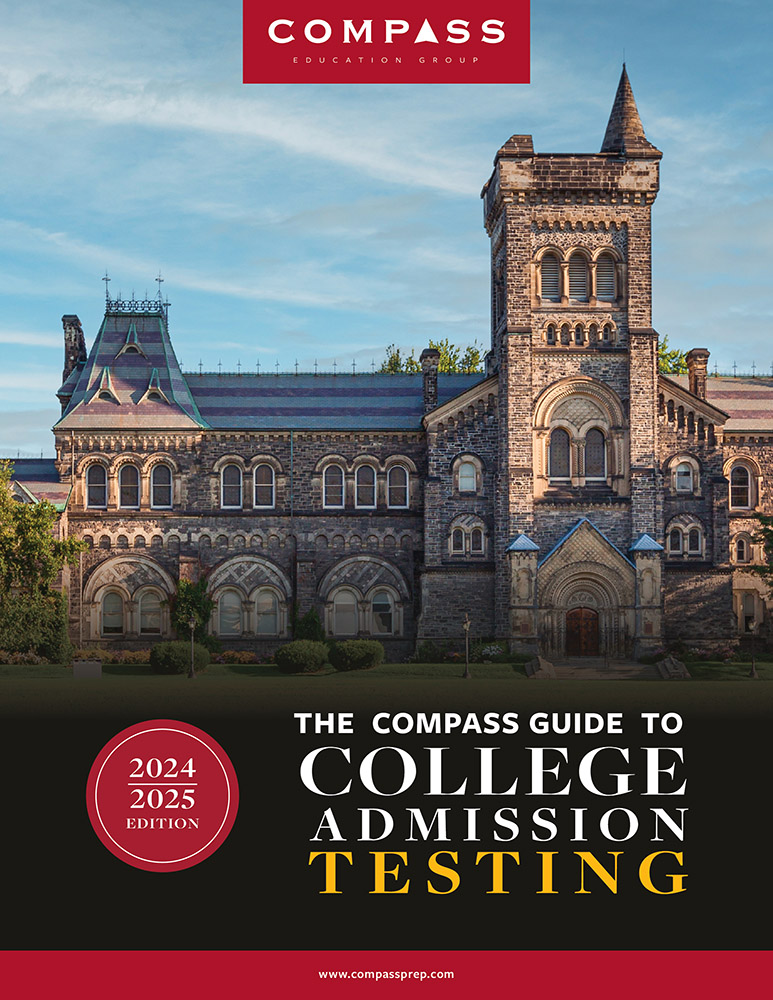
Hi,
I am from Nevada and qualified with a 225 index!! So excited!:)
Congratulations, Mark! Thanks for sharing the excitement.
I’m from SC and I feel like no one from my state makes a big deal out of this, but I really want to know! My school got a new principal this year and my counselor told me that he absolutely will not allow any names to go out until the 11th, so I guess all I do now is wait. I have a 219, which should be fine, but it is always nice to know things for certain rather than just speculating.
H,
It’s frustrating, since I’m sure your principal is just trying to follow the rules. NMSC merely asks schools not to publicly release the information prior to 9/11. It has never taken exception to principals or counselors privately communicating the information to students. As you say, you are in great shape at 219.
Apparently, my counselor was able to convince the new principal that it was okay to tell those who qualified before the 11th as long as we did not tell anyone (besides family). I have a 219 and qualified in SC.
Congratulations, H! Since you’ve remained anonymous, seems like you’ve adhered to the conditions. Thank you for the info.
Hi Art,
With CA and several other states going down a point, do you feel comfortable speculating on states like IL, TX and NY that have always been a point or two behind CA? Do you think this decreases those states chances of going up a point?
Thanks for everything.
Natalie,
Let me preface this by reminding people that it is just speculation. I’ll pass along any real information.
It’s certainly not bad news for students in IL/NY/TX. I like what we are seeing so far with CA and VA and some of the other states. My worst-case as a prognosticator is completely missing some big leap upward. It looks like I may have dodged that for another year. Each state is unique, though. Until last year, CA had always fallen a point or two behind New Jersey. Tomorrow is going to be a big day.
Can someone else confirm CA is a 222? My son has a 222 and we don’t want to get our hope up yet.
Art,
I’m from Colorado and my son is sitting on a 220. You wrote earlier you had confirmation that Colorado’s cutoff will be no higher than a 220. Did you get that confirmation from one or several parents? And how reliable is this information? 50%? 90? I don’t want to get my hopes up too high!!
Thank you!!
Hopeful,
Colorado happens to be the state where I feel the most confident, as the information comes directly from a school counselor. “Colorado HS counselor here–all of our students with an SI of 220 are semifinalists. We don’t have anyone with a 218-219 SI, so not sure if that score will be considered.” And, yes, name, email, and IP all check out. No guarantees, but it looks like you are set.
You’ve made my day!! Thank you Art for your prompt reply!!
Any news on CT?
Still waiting. Please let us know if you hear anything from your student’s school! Thanks.
Mom in CT,
My son is sitting on a 220. 760 in Math and 720 in EBRW (English). Had the scored been reversed, I would be confident. I think he falls short.
We’re in Texas and were notified by our school that they got letter today – my child qualified for national semi-finalist with 221 index.
Congratulations! Your student’s notification has made some other Texans happy, too.
THANK YOU SO MUCH! I LITERALLY SPENT THE ENTIRE DAY JUST REFRESHING THIS PAGE TO SEE IF TEXAS HAD UPDATED BECAUSE I SCORED A 221 AND I DIDN’T WANT TO MISS THE CUTOFF BY 1 POINT. YOU ARE LITERALLY AN ANGEL
Oh no my daughter got a 220 and she has miserable since she got her score that she most likely missed it by 1. I am hoping 221 isn’t Texas final number. I will have one crushed child.
My son has a 220 in AZ – so feeling hopeful but no official news from his school yet. I have been looking for information on when the application (including essays!) is due… anyone who has received an official letter, can you let me know? If this info is only available from last year, that would be helpful too just to have an idea… thanks!
Jen,
Hopefully a class of 2020 Semifinalist can get back to you with the latest information. Last year’s deadline was October 10th, and it usually falls in that same week from year-to-year. The deadline is for the school to submit the Finalist application, so it’s not just a student deadline.
In recent years, the essay prompt has gone unchanged. “To help the reviewers get to know you, describe an experience you have had, a person who has influenced you, or an obstacle you have overcome. Explain why this is meaningful to you. Use your own words and limit your response to the space provided.” The space allows for about 600-650 words. The rest of the Finalist application is basic background information and would take a prepared student about 30 minutes.
October 9 is the date for the schools to upload to NMSC (that is, if it’s the same as it is for ‘home schools’)
Thank you, Anonymous, it makes sense that it moved up a day.
How certain are you that the cutoff for CA will be 222?
Steve,
It comes from a student report. I have no reason not to believe it, but it would be nice to have a backup report given the importance of CA.
*waits anxiously for someone to post about a 219 in Arizona*
When the Oct 24th PSAT drops you 6 index points from your previous year and all you can do is hope😭
Good luck, Catherine! You deserve it after the Oct 24 test.
Hi Art,
I have a student at 216 in Maine; how sure are you that 216 qualifies? How come NMSC doesn’t just publish this info, why all the craziness of school only notification? Thanks so much for this service you provide!
The parent seemed quite certain in her report, but that’s all that I know. NMSC has been using the same model for about 60 years. It takes “if it ain’t broke…” to an absurd extreme. I guess we should be grateful that it finally allowed for ACT confirming scores. Change comes slowly.
Please, someone give news about pennsylvania!
216 is good for Nebraska!
Yay, another state heard from! Congratulations, Steph.
Art,
Thank you so much for providing this information for us! We really appreciate it.
Steph
John would like news from PA!
Still waiting to hear in WV. My son has a 219 so I feel fairly confident he will make it.
asloan12,
If 219 doesn’t qualify in WV, I’ll pack up this webpage and never post again. Congratulations!
Thank you! I just hope we hear soon.
Any news about MO?
Nothing, I’ll pass along your plea.
Please, anyone! Sitting on a 219 in Ohio and waiting to hear!
My daughter scored a 216 in Louisiana. We haven’t heard any news yet. Does this mean she got the score for national merit??? Waiting on pins and needles!
Based on the reports we have — which are most certainly not legally binding — it means she has qualified as a Semifinalist.
Confirming an Alabama 216 qualifies as a semi-finalist (I’ve seen the letter). Thanks Art for this forum!
Thanks, BD. Congratulations to your student!
Any news about Iowa?
I haven’t seen anything yet, Bob.
Does anyone have the cutoff from Michigan
Hoping to hear soon,
Got word this morning that my son qualified in OK with 216.
More happy news! Thanks, Jason, I’ll pass along the information.
DD qualified in TN with a 220! We found out this morning.
Congratulations, Kristen! I’ve updated the post.
Any updates from Missouri?
Sorry, no.
Florida is 219 for sure.
Sara,
I’ll ask before all of the students do: How are you so sure? Thank you.
Sure would love some more news from Georgia!! Have a son with a 221.
Me, as well! [The information part, not the son part.]
DD has a 221 in Georgia. Please come through for us! The waiting is so hard! Any GA people with info?
Given that CA went down (at least) one point – does that make it perhaps a little more likely that MD will go down similarly?
I think it is encouraging, but I don’t want to put too much emphasis on it yet.
Thank you! Would really like to hear some MD news, as son has a 222 . . .
Hi Art, thanks for this webpage. I’m wondering about any news from Oregon. We’re hoping for a cutoff that is less than or equal to 220. Does the move down of at least one point versus last year’s cutoff in CA increase the likelihood of the same in OR?
I haven’t heard from Oregon yet, Matt. We are definitely seeing that some states are moving down. Fingers crossed for Oregon.
Chiming in from Mississippi- my daughter qualified with 224 and reports that classmates with 214 also made it.
DCHS?